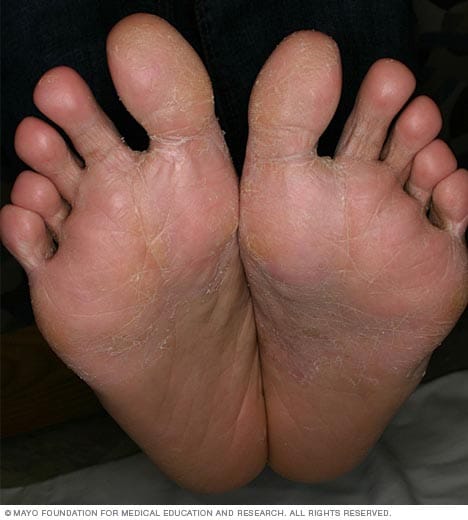Overview
Dyshidrosis

Dyshidrosis
Dyshidrosis causes small, fluid-filled blisters to form on the soles of the feet, the palms of the hands or sides of the fingers.
Dyshidrosis is a skin condition that causes small, fluid-filled blisters to form on the palms of the hands and sides of the fingers. Sometimes the bottoms of the feet are affected too.
The itchy blisters last a few weeks and often come back.
Treatment for dyshidrosis most often includes prescription steroid skin creams or ointments. Your doctor or other health care provider may suggest a different treatment, such as light therapy or medicine taken by mouth or injection. The right treatment depends on how severe your symptoms are.
Dyshidrosis is also called dyshidrotic eczema and pompholyx.
Products & Services
Symptoms
Dyshidrosis symptoms include painful, itchy and fluid-filled blisters on the sides of the fingers, the palms of the hands and the bottoms of the feet. The blisters are small — about the width of a standard pencil lead. They are grouped in clusters and can look like tapioca.
With severe disease, the small blisters can merge to form larger blisters. Skin affected by dyshidrosis can be painful and very itchy. After a few weeks, the blisters dry and flake off.
Dyshidrosis tends to come back regularly for months or years.
When to see a doctor
Call your doctor if you have a rash on your hands or feet that's severe, doesn't go away, or spreads beyond the hands and feet.
Causes
The cause of dyshidrosis isn't known. It tends to happen in people who have a skin condition called atopic dermatitis (eczema) and allergic conditions, such as hay fever or glove allergy. Dyshidrosis isn't contagious.
Risk factors
Risk factors for dyshidrosis include:
- Stress. Dyshidrosis appears to be more common during times of emotional or physical stress.
- Exposure to certain metals. These include cobalt and nickel — often in an industrial setting.
- Sensitive skin. People who develop a rash after contact with certain irritants are more likely to form the blisters of dyshidrosis.
- Atopic dermatitis. Some people with atopic dermatitis may have dyshidrosis.
Complications
For most people with dyshidrosis, it's just an itchy inconvenience. For others, the pain and itching may limit the use of their hands or feet. Intense scratching can increase the risk of a bacterial infection of the affected skin.
After healing, you may notice skin color changes in the affected area. This is called postinflammatory hyperpigmentation. It's more likely to occur in people with brown or Black skin. This complication most often goes away in time without treatment.
Prevention
There's no way to prevent dyshidrosis. It may help to manage stress and avoid exposure to metal salts, such as cobalt and nickel.
Good skin care practices may help protect the skin as well. These include:
- Using mild, nonsoap cleansers and lukewarm water to wash your hands.
- Drying your hands well.
- Applying moisturizer at least twice a day.
- Wearing gloves. But if you notice that wearing gloves worsens the rash, you may be sensitive to gloves. Let your doctor know about this. Try cotton gloves to prevent irritation. For wet activities, you might try wearing cotton gloves under waterproof gloves.